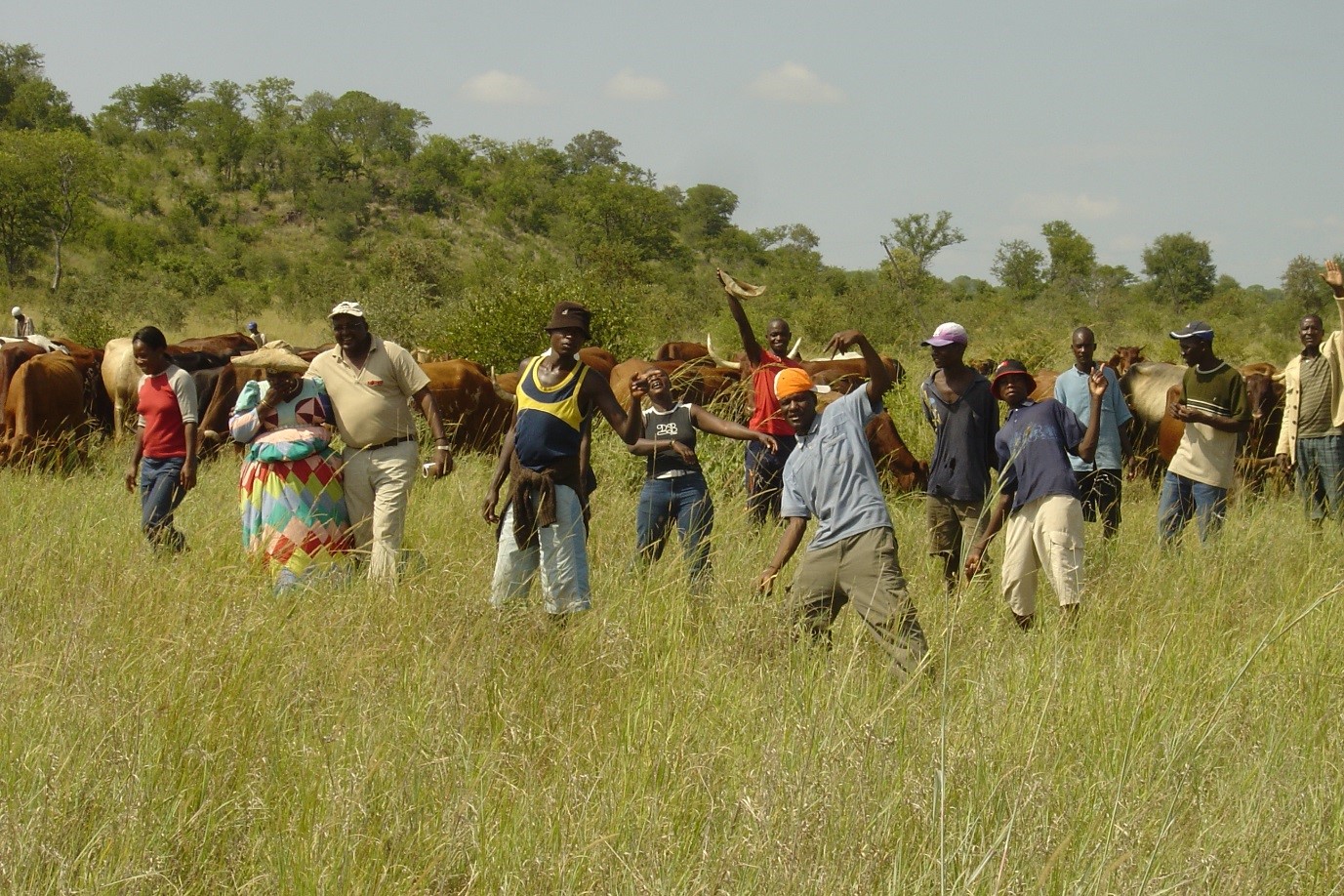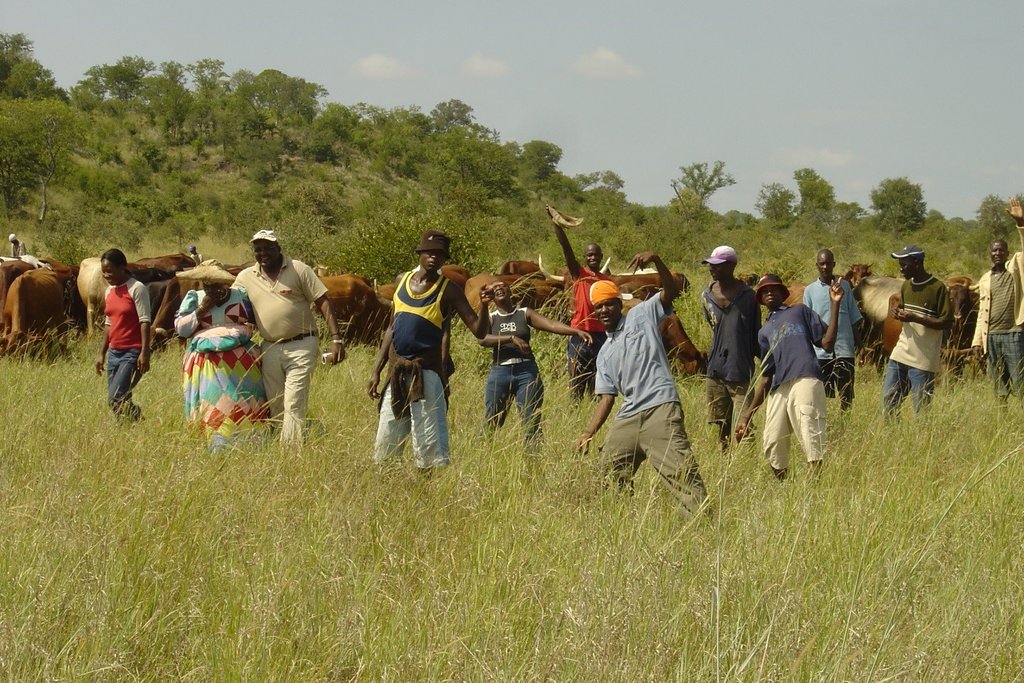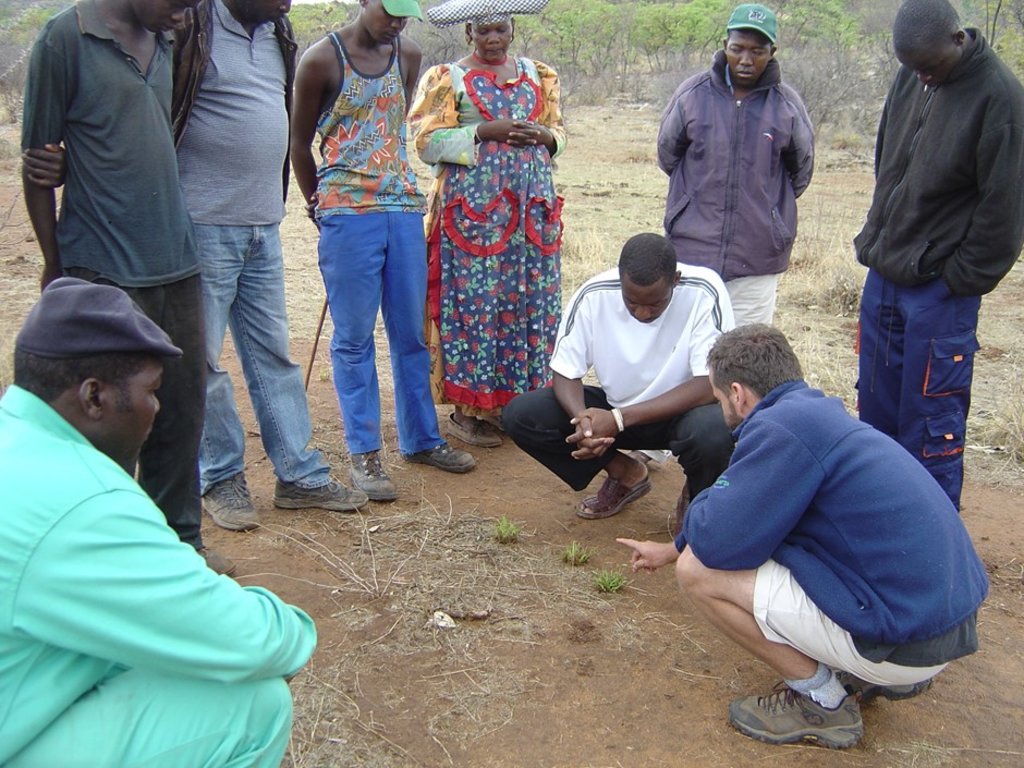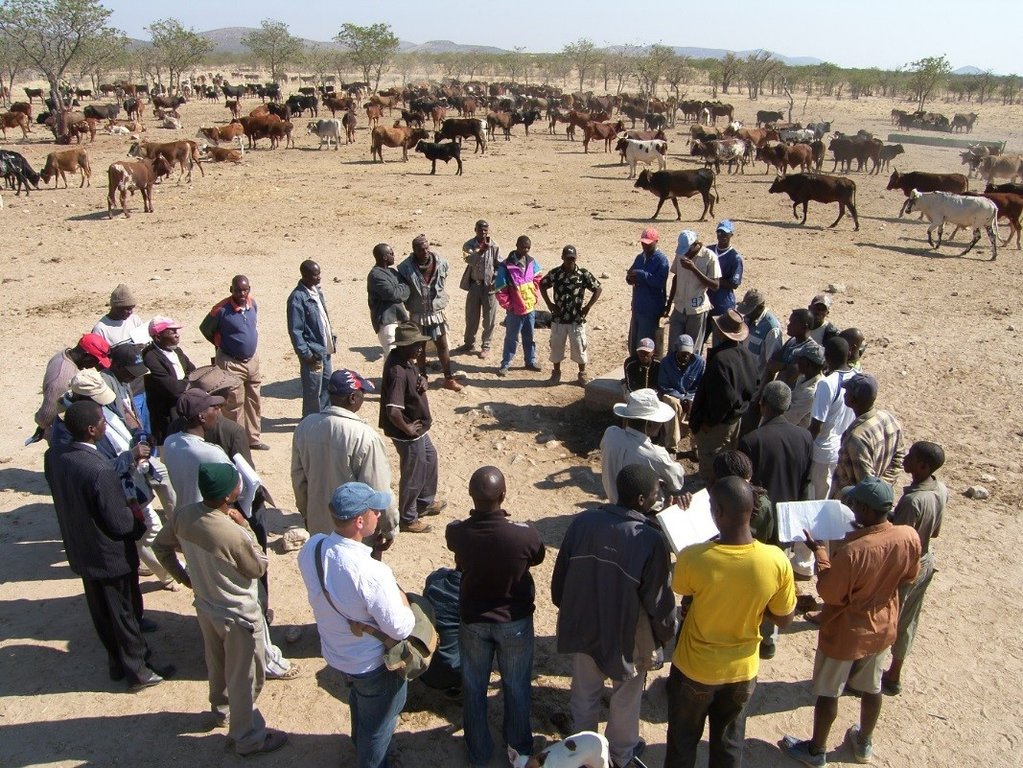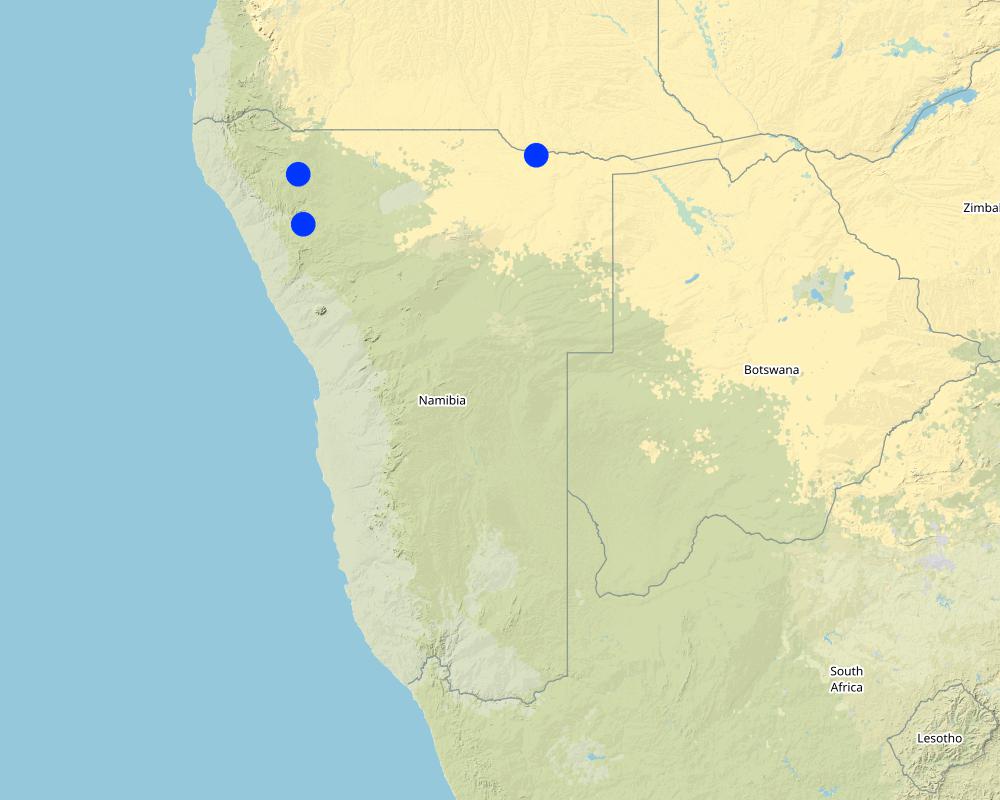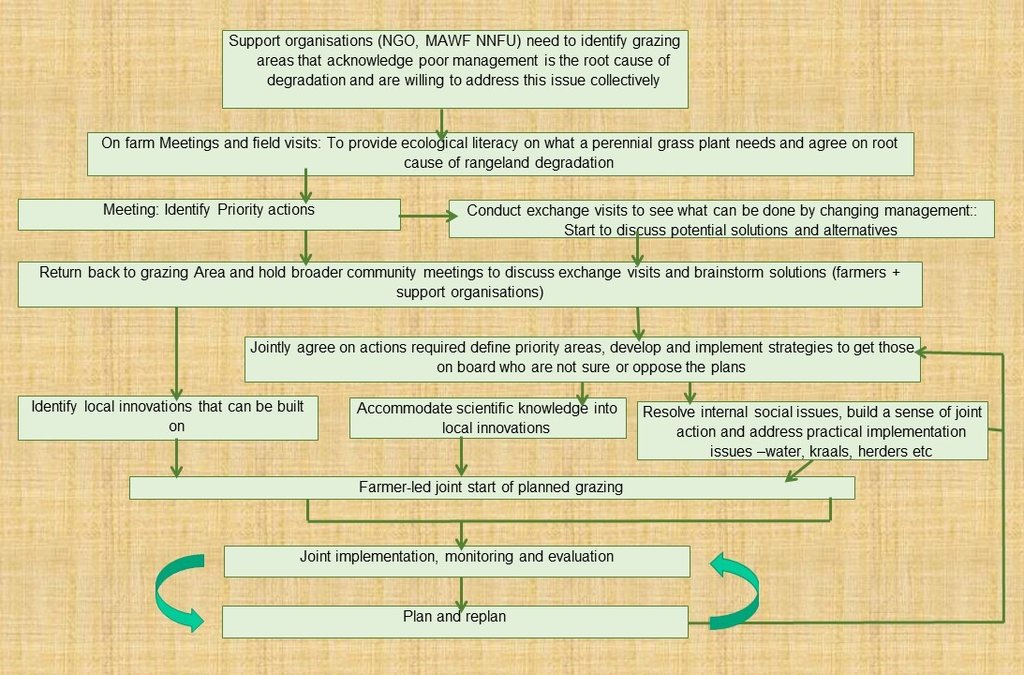Community grazing management [Namíbia]
- Criação:
- Atualização:
- Compilador/a: Ibo Zimmermann
- Editor: –
- Revisores: Rima Mekdaschi Studer, Joana Eichenberger
Omarisiro wovinamuinjo motjimbumba
approaches_3050 - Namíbia
Veja as seções
Expandir tudo Recolher tudo1. Informação geral
1.2 Detalhes do contato das pessoas capacitadas e instituições envolvidas na avaliação e documentação da abordagem
usuário de terra:
Nome do projeto que facilitou a documentação/avaliação da Abordagem (se relevante)
Southern African Science Service Centre for climate change and Adaptive Land management (SASSCAL)Nome do projeto que facilitou a documentação/avaliação da Abordagem (se relevante)
Book project: Guidelines to Rangeland Management in Sub-Saharan Africa (Rangeland Management)Nome da(s) instituição(ões) que facilitou(ram) a documentação/avaliação da Abordagem (se relevante)
Conservation Agriculture Namibia (Conservation Agriculture Namibia) - NamíbiaNome da(s) instituição(ões) que facilitou(ram) a documentação/avaliação da Abordagem (se relevante)
Zakumuka Producers Co-operative (Zakumuka Producers Co-operative) - Namíbia1.3 Condições em relação ao uso da informação documentada através de WOCAT
Quando os dados foram compilados (no campo)?
2017
O/a compilador/a e a(s) pessoa(s) capacitada(s) aceitam as condições relativas ao uso de dados documentados através da WOCAT:
Sim
1.4 Referência ao(s) questionário(s) sobre tecnologias da GST
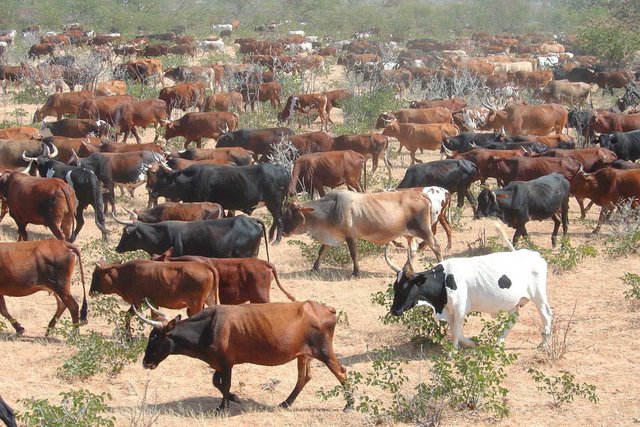
Combined herding for planned grazing [Namíbia]
Daily combining of livestock from all households into a single herd to be driven to different designated portions of the communal grazing area. Grass can then recover by replenishing its reserves before being re-grazed some months later.
- Compilador/a: Ibo Zimmermann
2. Descrição da abordagem de GST
2.1 Descrição curta da abordagem
Agreement among community members to jointly manage their communal grazing area by combining their livestock into a single herd. The herd is managed and moved according to an agreed growing season plan that provides sufficient recovery for perennial grasses, and a non-growing season plan to graze in a way that prepares soil and plants for the next season. Regenerating rangeland productivity and well-being is the goal.
2.2 Descrição detalhada da abordagem
Descrição detalhada da abordagem:
The approach is a partnership between an NGO, Ministry of Land Reform (MLR), Ministry of Agriculture , Water and Forestry (MAWF), the National Farmers Union (NNFU), traditional authorities, and regional and local government. The NGO raises awareness among the community about the damage caused to the rangeland by individual herds of livestock grazing continuously – and to appreciate the benefits of planned grazing. Livestock owners invite facilitators to compare the current state of their land with that of the past. The reasons for the decline are investigated. Once livestock owners understand that perennial grasses need recovery, they soon conclude that their management caused the loss of perennial grass and the increase in bare ground. At this point, the aim of the approach can be pursued. This is to regenerate rangeland productivity in the communal grazing area and thereby support higher livestock production. This in turn supports livelihoods.
If motivation to apply planned grazing exists among the community members, then their right to claim common property ownership needs to be established. In pioneering communities this requires at least 10 village level livestock owner meetings to decide on modalities of planned grazing. These meetings continue after planned grazing has started to deal with ongoing planning, animal production and marketing. Exposure visits to areas with successful grazing management help. On return frequent follow-up meetings, facilitated by the NGO and the MAWF, can resolve local issues, including traditional taboos, such as combining animals in one kraal, and whose bulls should be kept and managed.
Boundaries with neighbouring communities need to be mapped, recognised and respected by all. In case of grass poaching, the offenders must to be swiftly dealt with, preferably through customary law. A grazing plan needs to be agreed by all livestock owners, and endorsed by the local Traditional Authority. The grazing area (GA) is then mapped, while six herders, one of whom is their manager, are appointed from among the community though common agreement. Each livestock owner pays a portion of the herding and management cost pro-rata based on the number of his livestock. At night the cattle are separated and kraaled near the homesteads of their owners. In the morning, the herders collect cattle from the kraals. Different portions of the grazing area are grazed daily and only returned to when the grass has replenished its root reserves - some months later.
The process started at Erora in 2004, facilitated by the NGO, Integrated Rural Development and Nature Conservation (IRDNC). Implementation began in 2006, combining approximately 1200 cattle from 12 households. Livestock owners noticed a higher density of annual grasses after the first season; dramatic improvement in soil cover after three years with emergence of grass seedlings where none had grown for decades. Then after another three years, perennial grasses returned with increased biodiversity in many parts. However, when the extended drought started in 2011, planned grazing was interrupted and gullies expanded, down which rainwater flowed, dehydrating the rangelands. The drought lasted for five years, and the planned grazing was temporarily discontinued in 2013. During this period, rehabilitation work included constructing bush filters along key gullies: facilitation was taken over by another NGO, Conservation Agriculture Namibia (CAN). After successive years of severe drought, cattle became too weak to be rounded up, and in 2014 the community members decided to revert to keeping cattle near their homesteads. This was intended to be temporary but cattle only gained sufficient strength in 2017. The communal grazing management approach was extended to other villages in 2012, despite the drought. New boreholes were drilled and installed to facilitate improved planned grazing.
2.3 Fotos da abordagem
2.4 Vídeos da abordagem
Comentários, breve descrição:
www.youtube.com/watch?v=xNyFkDUH6MQ
This video is from a DVD created by the Integrated Rural Development and Nature Conservation (IRDNC), a Namibian NGO and co-sponsored by the Namibian Ministry of Agriculture and the Namibian National Farmers Union. The video documents the development of a rangeland program focused on Holistic Management, spearheaded by Colin Nott, a Holistic Management educator.
Data:
2007
Localização:
Erora, Namibia
Nome do cinegrafista:
Andrew Botelle
Comentários, breve descrição:
www.youtube.com/watch?v=3Ey5v40KtkI
Combined herding to manage communal grazing with the use of stress-free handling of cattle,
Data:
2007
Localização:
Erora, Namibia
Nome do cinegrafista:
Andrew Botelle
Comentários, breve descrição:
www.youtube.com/watch?v=6C4V_Cib8ts
Managing water flow to repair gully erosion
Data:
2015
Localização:
Namibia
Nome do cinegrafista:
Andrew Botelle
2.5 País/região/locais onde a abordagem foi aplicada
País:
Namíbia
Região/Estado/Província:
Kunene Region
Especificação adicional de localização:
Erora village, 18.32637 South, 14.05912 East
Map
×2.6 Datas de início e término da abordagem
Indique o ano de início:
2004
Comentários:
Combined herding was discontinued at Erora in 2013 due to extreme drought, which ended in 2016/2017 rainy season, and land users are planning to use reserved grazing, whereby cattle are taken out each day by herders and left there to return on their own to water points. In the meantime, combined herding has already resumed at the Outokotorua grazing area.
2.7 Tipo de abordagem
- Science informs the traditional practice
2.8 Principais metas/objetivos da abordagem
To regenerate rangeland productivity for supporting livelihoods and improved quality of life.
2.9 Condição que propiciam ou inibem a implementação de tecnologia/tecnologias aplicada(s) segundo a abordagem
Normas e valores sociais/culturais/religiosos
- Propício
Herding is customary, and the task is now shared among families
- Inibitivo
Herding no longer carries the high social status that it had previously.
Disponibilidade/acesso a recursos e serviços financeiros
- Propício
No bought inputs are required, and fewer herders needed than with many small herds. Also fewer losses from stock theft and predators
Quadro institucional
- Propício
A grazing area committee was established with support of livestock owners
- Inibitivo
The grazing area committee is not legally recognised
Colaboração/coordenção de atores
- Propício
Partnership approach with MLR, Ministry of Agriculture, Water and Forestry (MAWF) the NNFU, traditional authorities and regional and local government.
- Inibitivo
Resolution of local issues to apply grazing plans needs to be resolved
Quadro jurídico (posse de terra, direitos de uso da terra e da água)
- Propício
National Policy and strategy is in place which supports sound management principles
- Inibitivo
Grass poaching by neighbouring communities is not adequately dealt with by the law
Políticas
- Propício
The approach is based upon the Namibia National Rangeland Management Policy and Strategy
- Inibitivo
Common property rights are insufficiently promoted
Governança da terra (tomada de decisões, implementação e aplicação)
- Inibitivo
Lack of integration of different scales of management between conservancies at large scales and grazing areas at smaller scale is required
Conhecimento sobre GST, acesso a suporte técnico
- Propício
The awareness exists among participating livestock owners and stakeholders
Mercados (para comprar entradas, vender produtos) e preços
- Propício
The Namibia National Farmers Union is busy addressing markets north of the veterinary cordon fence, which maintains a zone free of foot-and-mouth disease to the south from where farmers are able to access the lucrative EU market
- Inibitivo
During drought the drop in prices from sudden increase in supply, results in inability of farmers to sell livestock when sudden shortage of forage occurs
Carga de trabalho, disponibilidade de força de trabalho
- Propício
Fewer herders are required for one large herd than for many small herds
- Inibitivo
The role of herders as rangeland managers lacks status and is not adequately appreciated, resulting in high turnover of trained herders and their manager.
Outro
- Inibitivo
One large livestock owner at a given place can hinder efforts of the majority to improve rangeland management
3. Participação e papel das partes interessadas envolvidas
3.1 Partes interessadas envolvidas na abordagem e seus papéis
- Usuários de terra/comunidades locais
Communities of Erora, Outokotorua and Nsindi
To organise, plan and implement
- Organizações comunitárias
Grazing Committee
Oversee day to day implementation
- Especialistas em GST/ consultor agrícola
Integrated Rural Development and Nature Conservation (IRDNC), then Conservation Agriculture Namibia (CAN) and Namibia National Farmers Union (NNFU)
To facilitate adoption and upscaling of the approach
- Pesquisadores
United States Department of Agriculture (USDA)
To assess rangeland condition changes
- Organização não governamental
First IRDNC, then CAN
To facilitate the approach
- Setor privado
Zakumuka Producers Cooperative
To organise auctions for sale of livestock
- Governo local
Traditional authorities
To support and enable agreed rules
- Governo nacional (planejadores, responsáveis pelas decisões)
Namibian Ministries of Lands & Agriculture
Assist with facilitation and support
- Farmers union
Namibia National Farmers Union
Enabling policy and legislation
Caso várias partes interessadas foram envolvidas, indique a agência líder:
Integrated Rural Development and Nature Conservation (IRDNC), taken over in 2014 by Conservation Agriculture Namibia (CAN)
3.2 Envolvimento do usuários de terra/comunidades locais nas diferentes fases da abordagem
| Envolvimento do usuários de terra/comunidades locais | Especifique quem estava envolvido e descreva as atividades | |
|---|---|---|
| Iniciação/motivação | Participativo | The community, with focus on livestock owners, youth, women and herders, under facilitation by NGO by conducting exchange visits to neighbouring countries |
| Planejamento | Participativo | Feedback was given to communities by participants of exchange visits, grazing committees appointed to contextualise and re-plan for the way forward under guidance of NGO, Ministry of Agriculture, Water and Forestry (MAWF) and Namibia National Farmers Union (NNFU) |
| Implementação | Participativo | The grazing committee, livestock owners and herders carry out the grazing plan with support of NGO, MAWF and NNFU |
| Monitoramento/avaliação | Participativo | The grazing committee and livestock owners constantly plan and replan and evaluate results on livestock performance and rangeland and daily check where livestock have grazed and where they will graze next and feed results into re-planning. Annual assessments of forage in May, to determine stocking rate. |
| external assessment of data | Apoio externo | External assessment by researchers of data gathered by USDA through Innovations for Poverty Action (IPA) |
3.3 Fluxograma (se disponível)
3.4 Decisão sobre a seleção de tecnologia/tecnologias de GST
Especifique quem decidiu sobre a seleção de tecnologia/tecnologias a serem implementadas:
- Principalmente usuários da terra, apoiados por especialistas em GST
Explique:
After exposure to sound management techniques and on farm identification and agreement on the root cause of the degradation – the farmers themselves decide if they will continue or not.
Especifique em que base foram tomadas as decisões:
- Avaliação de conhecimento bem documentado de GST (tomada de decisão baseada em evidências)
- Experiência pessoal e opiniões (não documentado)
4. Suporte técnico, reforço das capacidades e gestão do conhecimento
4.1 Reforço das capacidades/ formação
Foi oferecida formação aos usuários da terra/outras partes interessadas?
Sim
Especifique quem foi capacitado:
- Usuários de terra
- Equipe de campo/consultores
- Ministry of Agriculture, Namibia National Farmers Union.
Caso seja relevante, especifique gênero, idade, status, etnia, etc.
Inclusion of youth, women and herders.
Tipo de formação:
- Em exercício
- Agricultor para agricultor
- Reuniões públicas
Assuntos abordados:
On farm(s) exploration of root cause of degradation based on how it was in the past and how it looks now and why this change has happened.
Comentários:
A number of issues including: Rangeland management, focussing on the needs of grass plants and soil. Needs of herders, people and stakeholders and how these various needs can be met. Institutional support for grazing committee, focussing on budgeting and financial management.
4.2 Serviço de consultoria
Os usuários de terra têm acesso a um serviço de consultoria?
Sim
Especifique se foi oferecido serviço de consultoria:
- nas áreas dos usuários da terra
- Visits to successful farmers
Descreva/comentários:
Mostly through exchange visits, community meetings, on farm excursions and on-the-job training.
4.3 Fortalecimento da instituição (desenvolvimento organizacional)
As instituições foram fortalecidas ou estabelecidas através da abordagem?
- Sim, significativamente
Especifique a que nível (níveis) as instituições foram fortalecidas ou estabelecidas:
- Local
- Regional
Descreva instituição, papéis e responsabilidades, membros, etc.
Grazing Committee guides and implements the grazing plans and support organisations including Ministry of Agriculture, Namibia National Farmers Union and NGOs provide support and advice.
Especifique o tipo de apoio:
- Reforço das capacidades/ formação
- Equipamento
Dê mais detalhes:
Exchange visits, facilitation of meetings and on-the-job training. Drilling and equipping of boreholes. Redesign of water supply for livestock and combined kraaling system.
4.4 Monitoramento e avaliação
Monitoramento e avaliação são partes da abordagem?
Sim
Comentários:
To support decision making
Caso afirmativo, esta documentação é destinada a ser utilizada para monitoramento e avaliação?
Não
4.5 Pesquisa
A pesquisa foi parte da abordagem?
Sim
Especifique os tópicos:
- Sociologia
- Economia/Marketing
- Ecologia
Dê mais detalhes e indique quem realizou a pesquisa:
USDA/IPA came to evaluate rangelands and consult key stakeholders
5. Financiamento e apoio material externo
5.1 Orçamento anual para o componente de GST da abordagem
Indique o orçamento anual para o componente de GST da abordagem em US$:
10000,00
Caso o orçamento exato seja desconhecido, indique a faixa:
- 10.000-100.000
Comentários (p. ex. principais fontes de recursos/principais doadores):
Major donor to initiate the project was Enagelica Entwikelins Diens (EED), through IRDNC and later funding came from the Millenium Challenge Account (MCA), the EU and now the Finnish Embassy through CAN. Cost is per grazing area for local level field facilitation.
5.2 Apoio financeiro/material concedido aos usuários da terra
Os usuários da terra receberam apoio financeiro/material para a implementação de tecnologia/tecnologias?
Sim
Caso afirmativo, especifique tipo(s) de apoio, condições e fornecedor(es):
Upgrades of boreholes, drilling and equipping of new boreholes that are elephant-proof and construction of lion-proof kraaling was funded through the NGO.
5.3 Subsídios para entradas específicas (incluindo mão-de-obra)
- Mão-de-obra
| Em que medida | Especifique os subsídios |
|---|---|
| Parcialmente financiado | Part payment to herders 2004-2007 in Erora only |
- Outro
| Outros (especifique) | Em que medida | Especifique os subsídios |
|---|---|---|
| Boreholes and kraals | Parcialmente financiado | Erora upgrade USD 10 000, second solar borehole half funded by community USD 10 000. Lion proof kraal funded by Africat – USD 2 000 |
Se a mão-de-obra pelos usuários da terra foi uma entrada substancial, isso foi:
- Pago em dinheiro
Comentários:
Only for first four years at one of the villages to enable proof of concept to be established.
5.4 Crédito
Foi concedido crédito segundo a abordagem para atividades de GST?
Não
5.5 Outros incentivos ou instrumentos
Foram utilizados outros incentivos ou instrumentos para promover a implementação das tecnologias de GST?
Não
6. Análise de impactos e declarações finais
6.1 Impactos da abordagem
A abordagem concedeu autonomia aos usuários locais de terra, melhorou a participação das partes interessadas?
- Não
- Sim, pouco
- Sim, moderadamente
- Sim, significativamente
Through the whole approach.
A abordagem propiciou a tomada de decisão baseada em evidências?
- Não
- Sim, pouco
- Sim, moderadamente
- Sim, significativamente
Through observations by herders and livestock owners.
A abordagem auxiliou os usuários da terra a implementar e manter as tecnologias de GST?
- Não
- Sim, pouco
- Sim, moderadamente
- Sim, significativamente
Combined herding through planned grazing.
A abordagem melhorou a coordenação e a implementação economicamente eficiente da GST?
- Não
- Sim, pouco
- Sim, moderadamente
- Sim, significativamente
Key stakeholders are all involved.
A abordagem mobilizou/melhorou o acesso aos recursos financeiros para implementação da GST?
- Não
- Sim, pouco
- Sim, moderadamente
- Sim, significativamente
A abordagem aprimorou o conhecimento e as capacidades dos usuários da terra para implementar a GST?
- Não
- Sim, pouco
- Sim, moderadamente
- Sim, significativamente
Training provided the skills to self organise and implement activities based upon identification of root cause of land degradation.
A abordagem aprimorou o conhecimento e as capacidades de outras partes interessadas?
- Não
- Sim, pouco
- Sim, moderadamente
- Sim, significativamente
Ministries of Agriculture and Lands.
A abordagem construiu/fortaleceu instituições, colaboração entre partes interessadas?
- Não
- Sim, pouco
- Sim, moderadamente
- Sim, significativamente
Key stakeholders are all collaborating, since the solution to rangelands cuts across various sectors.
A abordagem atenuou conflitos?
- Não
- Sim, pouco
- Sim, moderadamente
- Sim, significativamente
Reinstated sense of community
A abordagem concedeu autonomia aos grupos social e economicamente desfavorecidos?
- Não
- Sim, pouco
- Sim, moderadamente
- Sim, significativamente
Women-headed households now have their livestock herded communally.
A abordagem melhorou a igualdade de gêneros e concedeu autonomia a mulheres e meninas?
- Não
- Sim, pouco
- Sim, moderadamente
- Sim, significativamente
Women-headed households now have their livestock herded communally.
A abordagem encorajou os jovens/as próximas gerações de usuários de terra a se envolverem na GST?
- Não
- Sim, pouco
- Sim, moderadamente
- Sim, significativamente
Herders are mainly youth and young livestock owners, who appreciate improved rangeland and are now willing to remain.
A abordagem melhorou as questões de posse de terra/diretos do usuário que inibiam a implementação das tecnologias de GST?
- Não
- Sim, pouco
- Sim, moderadamente
- Sim, significativamente
The willingness to address appropriate land rights may initiate resolution of land issues.
A abordagem resultou em segurança alimentar aprimorada/nutrição melhorada?
- Não
- Sim, pouco
- Sim, moderadamente
- Sim, significativamente
Much during good rains and little during drought.
A abordagem melhorou o acesso aos mercados?
- Não
- Sim, pouco
- Sim, moderadamente
- Sim, significativamente
A abordagem resultou em acesso melhorado à água e ao saneamento?
- Não
- Sim, pouco
- Sim, moderadamente
- Sim, significativamente
Access to borehole water was provided.
A abordagem resultou em uso/fontes de energia mais sustentável?
- Não
- Sim, pouco
- Sim, moderadamente
- Sim, significativamente
Solar installations were installed or replaced diesel where possible for pumping of water.
A abordagem aprimorou a capacidade dos usuários da terra de adaptar-se a mudanças climáticas/extremos e atenuar os desastres relacionados com o clima?
- Não
- Sim, pouco
- Sim, moderadamente
- Sim, significativamente
Improved grass growth in good rain years and improved survival in drought.
A abordagem resultou em emprego, oportunidades de renda?
- Não
- Sim, pouco
- Sim, moderadamente
- Sim, significativamente
Herders and managers were appointed.
6.2 Principal motivação dos usuários da terra para implementar a GST
- Produção aumentada
Increased grass, higher calving and reduced mortalities.
- Lucro (lucrabilidade) aumentado, melhora da relação custo-benefício
Increased grass, higher calving and reduced mortalities.
- Degradação do solo reduzida
Changing unsustainable practices for improved resource base.
- Carga de trabalho reduzida
Fewer herders needed.
- Prestígio, pressão social/coesão social
Social cohesion to implement joint management.
- Consciência ambiental
To support the future of livestock in their area.
6.3 Atividades de sustentabilidade de abordagem
Os usuários da terra podem manter o que foi implementado através da abordagem (sem apoio externo)?
- Sim
Caso afirmativo, descreva como:
They mobilise themselves, appoint herders, do the implementation, do the planning jointly and, and only asking for some technical support.
6.4 Pontos fortes/vantagens da abordagem
| Pontos fortes/vantagens/oportunidades na visão do usuário da terra |
|---|
| By caring for the rangeland, farmers will have grass all year round and minimise effects of drought. |
| Pontos fortes/vantagens/oportunidades na visão do/a compilador/a ou de outra pessoa capacitada |
|---|
| It has proven to improve the resource base if applied properly. |
| It is viable and upscalable. |
| It has diverse benefits for the land user, including economic, social and environmental. |
6.5 Pontos fracos, desvantagens da tecnologia e formas de superá-los
| Pontos fracos/desvantagens/riscos na visão do usuário da terra | Como eles podem ser superados? |
|---|---|
| If a new water point needs to be developed, then funds will be required | Convince land users that by selling one or a few cattle to invest in a new water point, they will realise the returns from increased productivity within a few years. |
| Pontos fracos/vantagens/riscos na visão do/a compilador/a ou de outra pessoa capacitada | Como eles podem ser superados? |
|---|---|
| The herding is hard work, the status of herders is perceived to be low and they are poorly compensated. |
Convince livestock owners that they can adequately afford to compensate the herders. Start national and regional vocational training in herding, grazing management, low-stress handling, animal health, rangeland management, water management and financial and farm management. |
7. Referências e links
7.1 Métodos/fontes de informação
- visitas de campo, pesquisas de campo
- entrevistas com usuários de terras
- entrevistas com especialistas em GST
7.2 Referências às publicações disponíveis
Título, autor, ano, ISBN:
Global case studies of grazing in nature’s image, Jim Howell, 2008, 1-4392-1610-X
Disponível de onde? Custos?
www.booksuge.com
7.3 Links para informação relevante que está disponível online
Título/ descrição:
Community based rangeland and livestock management
URL:
https://rmportal.net/groups/cbrlm/cbrlm-for-review/namibia-community-based-rangeland-livestock-management-cbrlm-2nd-edition/view
Links e módulos
Expandir tudo Recolher tudoLinks

Combined herding for planned grazing [Namíbia]
Daily combining of livestock from all households into a single herd to be driven to different designated portions of the communal grazing area. Grass can then recover by replenishing its reserves before being re-grazed some months later.
- Compilador/a: Ibo Zimmermann
Módulos
Não há módulos


